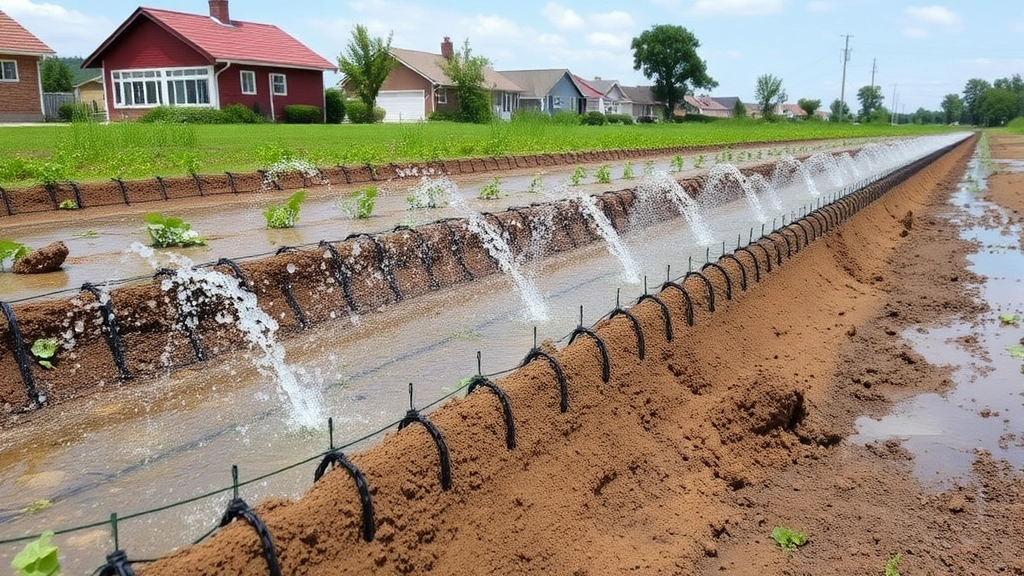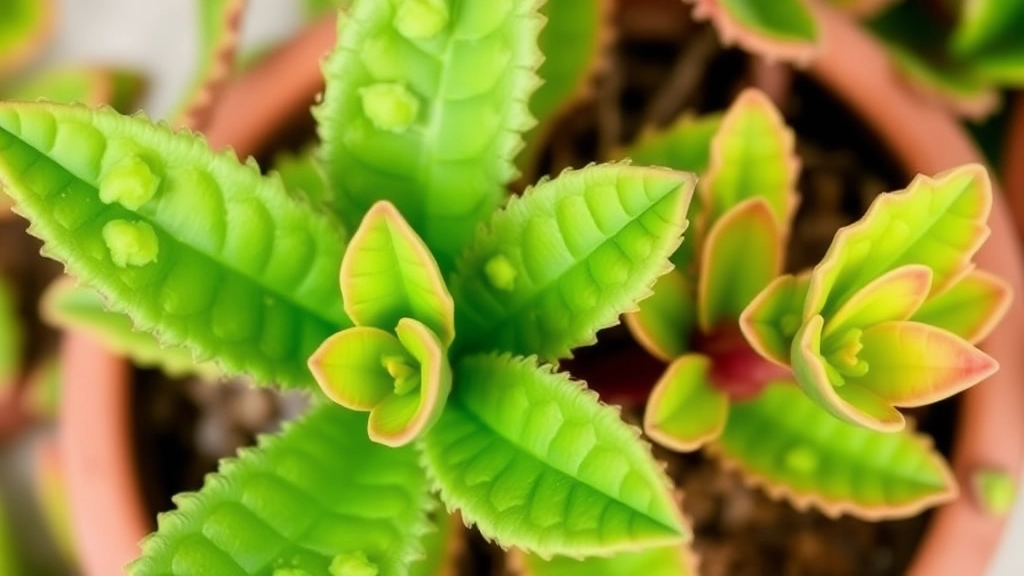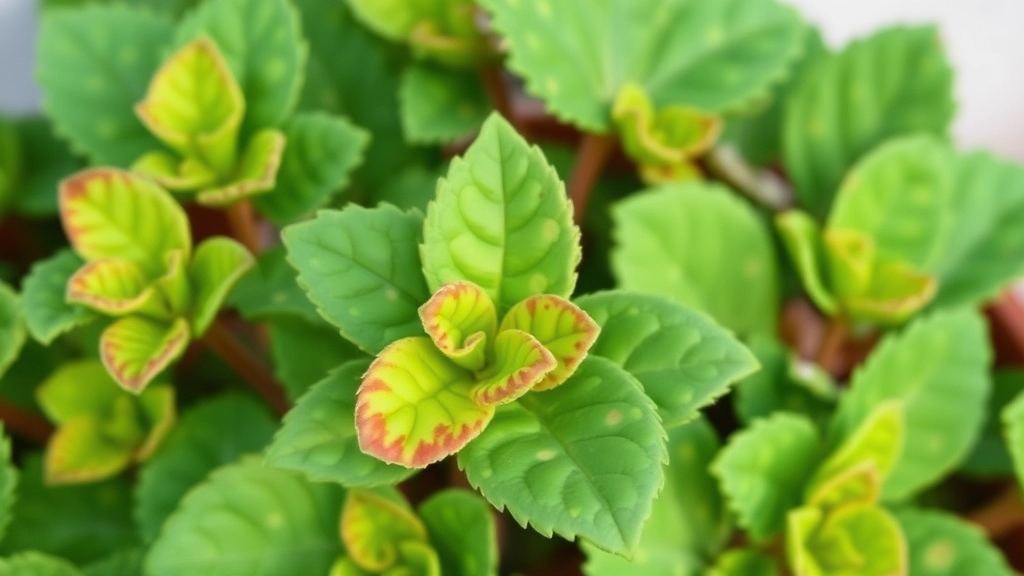Understanding Brown Spots on Kalanchoe Leaves
Are you noticing brown spots on Kalanchoe leaves and wondering what might be causing them? You’re not alone. Many plant enthusiasts face this issue, and it can be quite frustrating. Brown spots on Kalanchoe leaves are usually a sign of underlying problems that need immediate attention. Let’s dive into what might be causing these spots and how you can fix them.
Check Your Watering Habits
First, it’s essential to check your watering habits. Overwatering is a common culprit that leads to brown spots on Kalanchoe leaves. Ensure you’re allowing the soil to dry out between waterings.
Consider Light and Humidity Levels
Additionally, consider the plant’s exposure to light and humidity levels. Both too much and too little can stress the plant, resulting in those pesky brown spots. By adjusting these factors, you can help your Kalanchoe thrive and keep its leaves spot-free.
Common Causes of Brown Spots on Kalanchoe Leaves
Are you noticing unsightly brown spots on your Kalanchoe leaves? You’re not alone. Many plant enthusiasts encounter this frustrating issue, and it can stem from various causes. Understanding these common culprits is the first step in restoring your plant’s health.
1. Fungal Infections
Fungal infections are a primary reason for brown spots. They thrive in damp conditions, often manifesting as dark, irregular patches on the leaves. If you notice a fuzzy texture or a powdery residue, it’s likely a fungal issue.
2. Bacterial Problems
Bacterial infections can also lead to brown spots. These often appear as water-soaked areas that may eventually turn brown. If the leaves feel mushy or have an unpleasant smell, it’s time to act.
3. Overwatering
Overwatering is a common mistake. It can suffocate roots and create a breeding ground for pathogens. If your Kalanchoe leaves are turning brown and feel soft, overwatering might be to blame.
4. Underwatering
Conversely, underwatering can cause stress, leading to brown spots. If the leaves appear shriveled or crispy, your plant may be thirsty.
5. Pests
Pests like mealybugs and spider mites can cause discoloration. Look for tiny webs or cotton-like clusters. These pests can sap your plant’s vitality, resulting in brown spots.
6. Nutrient Deficiencies
A lack of essential nutrients can manifest as brown spots. If your Kalanchoe is not getting enough magnesium or potassium, you might see discoloration. Regular feeding can help prevent this.
7. Environmental Stress
Extreme temperatures or sudden changes in light can stress your plant. If it’s too hot, too cold, or suddenly exposed to direct sunlight, you may notice brown spots developing. For more detailed information on optimal growing conditions, check out our guide on whether Kalanchoe can thrive in full sun. Additionally, proper post-flowering care is crucial for maintaining plant health; learn more in our post-flowering care tips for Kalanchoe.
Identifying Fungal Infections

Are your Kalanchoe leaves showing brown spots, and you’re wondering if it’s a fungal infection?
Let’s dive into the signs and symptoms that can help you identify if your plant is battling a fungus.
Signs of Fungal Infections
- Spot Patterns: Look for irregular brown spots that may have a yellow halo around them. This is often a telltale sign of a fungal issue.
- Leaf Texture: If the spots feel fuzzy or powdery, that’s a strong indicator of fungal growth.
- Spread: Fungal infections can spread quickly. If you notice spots multiplying, it’s time to take action.
- Wilting: Affected leaves may start to wilt or curl, which can be alarming, but it’s a common reaction to fungal stress.
Common Fungal Types
- Powdery Mildew: This appears as a white, powdery substance and can affect the entire plant if not managed.
- Leaf Spot Fungi: These cause those pesky brown spots we’re concerned about.
What to Do Next
If you suspect a fungal infection, it’s crucial to act fast.
- Isolate the Plant: Keep it away from your other plants to prevent spreading.
- Improve Air Circulation: Make sure your Kalanchoe isn’t too crowded.
- Adjust Watering: Overwatering creates a perfect environment for fungi.
Detecting Bacterial Issues
Have you noticed brown spots on your Kalanchoe leaves that seem to spread rapidly? Bacterial infections can be sneaky and often mimic other issues, making it crucial to identify them early.
Impact of Overwatering

Have you noticed brown spots on your Kalanchoe leaves and wondered if overwatering could be the culprit?
Overwatering is one of the most common issues that can lead to leaf discoloration in Kalanchoe plants.
When the roots sit in waterlogged soil, they can become suffocated and begin to rot. This condition not only affects the plant’s ability to absorb nutrients but also creates a breeding ground for fungal infections.
Signs of Overwatering
- Yellowing Leaves: Leaves may turn yellow before browning.
- Soft, Mushy Texture: Affected leaves may feel soft or mushy to the touch.
- Foul Odour: The soil may emit a foul smell, indicating root rot.
- Wilting: Surprisingly, overwatered plants can also exhibit wilting.
How to Address Overwatering
- Check Soil Moisture: Use your finger to gauge the moisture level. If the top inch is still wet, hold off on watering.
- Improve Drainage: Ensure your pot has drainage holes and consider using a well-draining soil mix.
- Repot if Necessary: If root rot is suspected, gently remove the plant, trim away the affected roots, and repot in fresh soil.
- Adjust Watering Schedule: Water less frequently, allowing the soil to dry out between waterings.
Consequences of Underwatering
Have you ever noticed brown spots on your Kalanchoe leaves and wondered if underwatering might be the culprit?
Underwatering is a common issue that can lead to various problems, including unsightly brown spots on your plant’s leaves.
When Kalanchoe plants do not receive enough water, they become stressed, which can manifest in several ways:
- Leaf Curling: Leaves may curl or become crispy as they try to conserve moisture.
- Brown Edges: The tips and edges of the leaves can turn brown and dry out.
- Stunted Growth: A lack of water can hinder overall growth, leaving your plant looking unhealthy.
To tackle underwatering, consider the following tips:
- Check Soil Moisture: Insert your finger about an inch into the soil. If it feels dry, it’s time to water.
- Regular Watering Schedule: Establish a routine, typically every 1-2 weeks, depending on your environment.
- Use Well-Draining Soil: This helps prevent waterlogging while ensuring your plant gets the moisture it needs.
A story that comes to mind is when a friend of mine had a beautiful Kalanchoe that seemed to be wilting. After some investigation, he realised he had forgotten to water it for weeks. Once he started a consistent watering routine, the plant perked up and the brown spots began to fade.
For more in-depth information on how to care for your Kalanchoe, you might find our Complete Care Guide for Kalanchoe Orange Plant helpful. Additionally, if you’re dealing with specific issues like leggy growth, check out our Expert Tips for Fixing a Leggy Kalanchoe.
Role of Pests in Leaf Discoloration

Have you ever noticed those pesky brown spots on your Kalanchoe leaves and wondered if pests might be the culprit? You’re not alone in this worry.
Pests can wreak havoc on our beloved plants, and spotting them early is key to keeping your Kalanchoe healthy. Here’s what you need to know:
Common Pests to Watch For:
- Mealybugs: These little white fluffballs often hide in the leaf axils. They suck the sap, leading to yellowing and brown spots.
- Spider Mites: Tiny and often hard to see, they create fine webs and can cause significant leaf discoloration.
- Aphids: These tiny green or black bugs also suck sap, leading to wilting and brown spots.
- Scale Insects: They look like small bumps on the leaves and can cause similar damage.
Signs of Pest Infestation:
- Visible bugs on the leaves or stems.
- Sticky residue (honeydew) on the leaves.
- Webbing, especially with spider mites.
- Leaves curling or wilting along with those brown spots.
What Can You Do?
- Inspect Regularly: Make it a habit to check your Kalanchoe for pests.
- Natural Remedies: Spray with insecticidal soap or neem oil to tackle infestations without harsh chemicals.
- Isolation: If you spot pests, move the affected plant away from others to prevent spreading.
Nutrient Deficiencies and Leaf Health
Have you ever noticed your Kalanchoe leaves developing brown spots and wondered if it could be linked to nutrient deficiencies?
Nutrient deficiencies can significantly impact the health and appearance of Kalanchoe plants.
Understanding which nutrients are essential and how to identify deficiencies is key to maintaining vibrant leaves.
Environmental Stress Factors

Ever looked at your Kalanchoe and wondered why those lovely leaves are turning brown?
Environmental stress can play a huge role in leaf health, and it’s something many plant owners overlook.
Here are some common environmental stress factors that could be causing those brown spots:
- Temperature Fluctuations: Kalanchoes thrive in warm conditions. Sudden changes in temperature, like moving them from a warm room to a chilly draft, can shock the plant.
- Humidity Levels: These plants prefer a moderate humidity level. Too much dryness in the air can lead to leaf stress, resulting in brown spots.
- Light Exposure: While Kalanchoes love bright light, too much direct sunlight can scorch their leaves. If you notice brown patches, it might be time to adjust their spot.
- Air Quality: Pollutants or chemicals in the air can also stress your plant. Keep them away from areas with heavy fumes or smoke.
- Seasonal Changes: As seasons shift, so do the needs of your plant. In winter, they might need less water and more light.
Being mindful of these factors can make a significant difference in your plant’s health.
Prevention and Maintenance Tips
When it comes to keeping your Kalanchoe healthy, prevention is always better than cure. Many plant owners often wonder how to avoid brown spots on Kalanchoe leaves before they become a serious issue.
Here are some essential tips to maintain your Kalanchoe’s vibrant health:
Treatment Options for Affected Leaves on Kalanchoe

So, you’ve spotted those pesky brown spots on your Kalanchoe leaves, and you’re understandably worried. What do you do next?
First things first, it’s crucial to identify the underlying issue before jumping into treatment. Once you know whether it’s a fungal infection, bacterial problem, or something else, you can tailor your approach. Here are some practical treatment options to consider:
1. Fungal Infections
- Remove Affected Leaves: Snip off any leaves showing signs of infection. This helps prevent the spread.
- Fungicidal Spray: Use a mild fungicide, following the instructions carefully. Neem oil is a great organic option.
- Improve Air Circulation: Ensure your plant isn’t overcrowded. This helps reduce humidity around the leaves.
2. Bacterial Issues
- Prune Affected Areas: Just like with fungus, cut away any damaged parts.
- Disinfect Tools: Always use clean, sterilised tools to avoid spreading bacteria.
- Watering Technique: Water at the base to keep leaves dry.
3. Overwatering
- Adjust Watering Schedule: Let the soil dry out completely before the next watering. Kalanchoes prefer drier conditions.
- Repot if Necessary: If the roots are rotting, consider repotting in fresh, well-draining soil.
4. Underwatering
- Increase Water Frequency: If your plant’s leaves are shrivelling, give it a good soak.
- Check Soil Moisture: Use your finger to feel the soil; it should be slightly damp, not soggy.
5. Pest Control
- Inspect for Pests: Look for tiny bugs like aphids or mealybugs.
- Insecticidal Soap: A gentle spray can help eliminate pests without harming the plant.
6. Nutrient Deficiencies
- Fertilise Wisely: Use a balanced fertiliser during the growing season to boost nutrient levels.
- Organic Options: Consider using compost or worm castings for a natural nutrient boost.
7. Environmental Stress
- Relocate Your Plant: If your Kalanchoe is in direct sunlight or too drafty, move it to a more suitable spot.
- Monitor Temperature: Aim for a stable environment, ideally between 15-25°C.
As we navigate the complexities of Kalanchoe care, you may find yourself facing challenges that feel overwhelming.
### Recognising the Signs
When should you consider reaching out to a professional? Here are some signs that indicate it’s time to seek expert advice:
– **Persistent Brown Spots**: If brown spots continue to spread despite your best efforts, it may signal a deeper issue.
– **Rapid Leaf Decline**: Sudden wilting or leaf drop can indicate severe stress or disease.
– **Unidentified Pests**: If you notice pests that you cannot identify or control, it’s best to consult a specialist.
– **Fungal or Bacterial Infections**: If symptoms appear severe and you suspect a serious infection, professional diagnosis is crucial.
### Why Consult an Expert?
Seeking professional help can offer several benefits:
– **Accurate Diagnosis**: Experts can identify specific diseases or pests that may be affecting your plant.
– **Tailored Treatment Plans**: Professionals can recommend targeted treatments that are effective for your specific situation.
– **Long-term Health**: They can provide advice on maintaining the overall health of your Kalanchoe, preventing future issues.
### Finding the Right Help
When looking for professional assistance, consider these options:
– **Local Garden Centres**: Many have knowledgeable staff who can offer advice and support.
– **Online Forums**: Communities dedicated to plant care can provide insights and recommendations.
– **Plant Clinics**: Some universities and botanical gardens offer diagnostic services for plant health.
If you find yourself unsure about the health of your Kalanchoe, don’t hesitate to reach out for help. For more detailed advice on maintaining your plant, check out our [complete care guide for Kalanchoe Beharensis Variegated](https://planthq.org/complete-care-guide-for-kalanchoe-beharensis-variegated/) and learn about the [causes and solutions for black spots on Kalanchoe leaves](https://planthq.org/causes-and-solutions-for-black-spots-on-kalanchoe-leaves/).
FAQs on Brown Spots on Kalanchoe Leaves
What are the signs of fungal infections on Kalanchoe leaves?
Look for irregular brown spots with yellow halos, fuzzy or powdery leaf textures, quick spread of spots, and wilting or curling leaves.
What types of fungi commonly affect Kalanchoe plants?
Common types include Powdery Mildew, which appears as a white powdery substance, and Leaf Spot Fungi that cause brown spots.
How can I address fungal infections on my Kalanchoe?
Isolate the plant, improve air circulation, and adjust watering habits. Consider using a fungicidal spray or neem oil.
Can overwatering cause brown spots on Kalanchoe leaves?
Yes, overwatering can lead to root rot and fungal infections, both of which can cause brown spots on the leaves.
What are the signs of overwatering in Kalanchoe plants?
Signs include yellowing leaves, soft or mushy leaf texture, foul odour from the soil, and wilting.
How can I fix overwatering issues?
Check soil moisture, improve drainage, repot if necessary, and adjust your watering schedule to allow the soil to dry out between waterings.
What pests should I watch for that cause brown spots on Kalanchoe leaves?
Common pests include Mealybugs, Spider Mites, Aphids, and Scale Insects.
What are the signs of pest infestation on Kalanchoe leaves?
Look for visible bugs, sticky residue, webbing, and leaves curling or wilting along with brown spots.
How can I manage pest infestations?
Inspect your plant regularly, use natural remedies like insecticidal soap or neem oil, and isolate affected plants.
Can environmental stress cause brown spots on Kalanchoe leaves?
Yes, factors like temperature fluctuations, low humidity, excessive light exposure, poor air quality, and seasonal changes can cause brown spots.
What can I do to reduce environmental stress on my Kalanchoe?
Maintain stable temperatures, moderate humidity, appropriate light exposure, good air quality, and adjust care routines with seasonal changes.
What are some treatment options for brown spots on Kalanchoe leaves?
Treatment depends on the underlying issue. Options include removing affected leaves, using fungicidal sprays, adjusting watering schedules, repotting, increasing water frequency, inspecting for pests, using insecticidal soap, and fertilising wisely.
References
-
Why Are My Kalanchoe Leaves Turning Brown?
-
Kalanchoe Plant Care: How to Grow Kalanchoes
-
Kalanchoe: How to Grow and Care for Kalanchoe Plants
